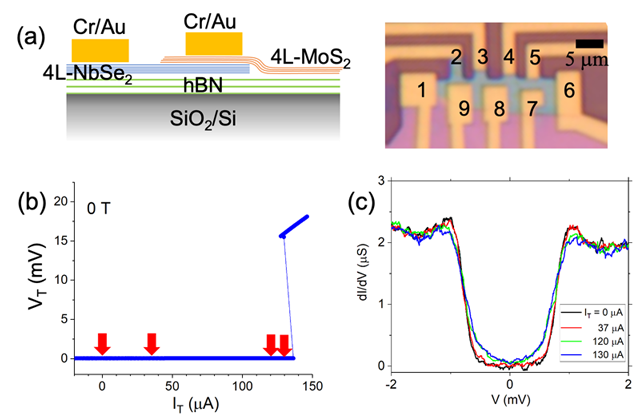PC4-6
Tunnel spectroscopy of atomically thin NbSe2 superconducting films carrying a supercurrent
*Hikari Tomori1, Riki Yanai1, Masato Ishikawa1, Kenji Watanabe2, Takashi Taniguchi2, Masahiko Hayashi3, Akinobu Kanda1
- Department of Physics, University of Tsukuba, Japan1
- NIMS, Japan1
- Faculty of Education and Human Studies, Akita University, Japan1
Owing to development of micro-cleavage and stacking techniques of two-dimensional (2D) materials, it becomes possible to investigate atomically thin and very clean superconductors in recent years. In such systems, anomalous metallic state called quantum metal has been observed, in which the resistance saturates to a finite value in magnetic fields even in the zero-temperature limit.[1] Such a 2D metallic state has never been expected in conventional 2D systems due to Anderson localization, so that the physical origin of the quantum metallic state is controversial. So far, there has been no report on tunnel spectra in the quantum metal state. Here, we performed transport measurement and tunnel spectroscopy simultaneously.
The sample is four-layer 2H-NbSe2 which is sandwiched between hBN and four-layer MoS2 as shown in Fig. (a). This structure was made in a glove box filled with inert gas. Ohmic contacts (contact 1 to 6 in optical image of Fig. (a)) for transport measurement and tunnel contacts (contacts 7 to 9 in Fig. (a)) for tunnel spectroscopy are attached to the 4L-NbSe2. 4L-MoS2 is used as a tunnel barrier. The superconducting transition temperature is Tc = 6.3 K, at which the resistance becomes 50% of the normal state resistance. This value agrees with the literature values. The residual resistance ratio (RRR) was 7. We observed Kosterlitz-Thouless transition of vortices with the transition temperature TKT = 5.7 K, which was determined from the square-root-cusp behavior of resistance and the universal jump in the power-law behavior of the current-voltage characteristics. These results indicate that the quality of our sample is similar to those in the literature.
In transport measurement, we did not observe any quantum-metallic behavior in magnetic fields, while in ref.[1], clear quantum metal state was observed in 4L-NbSe2. This issue will be a topic in another presentation. Here, we focus on the tunnel spectroscopy of 4L-NbSe2 carrying a supercurrent. In the measurement, tunnel spectroscopy was performed for contact 8, in which the voltage between contacts 4 and 8 was measured as a function of the tunneling current injected from contact 8. The transport current IT flowed between contacts 1 and 6. The measurements shown here were performed at 0.1 K.
Figure (b) shows the four-terminal current-voltage (IT-VT) characteristics of the 4L-NbSe2 film. VT is the voltage between contacts 2 and 5. The voltage is zero within the measurement accuracy below 138 μA, and at 138 μA, the voltage jumps up and resistance takes the normal state value. We performed tunnel spectroscopy for IT = 0, 37, 120, and 130 μA (indicated by arrows in Fig. (b)), at which the film is in the zero-resistance state. The results are shown in Fig. (c). The tunnel spectra for 0 and 37 μA are almost identical, while those for 0 and 120 (130) μA exhibit slight difference. We found that the spectra for 120 and 130 μA is almost identical to those for IT = 0 μA and perpendicular magnetic field B = 25 mT. Since the IT -induced magnetic field is negligible (around 0.02 mT), we conclude that the change in the tunnel spectra for IT = 120 and 130 μA comes from modulation by the supercurrent.
In the presentation, we will also discuss the effect of the flux-flow states and the phase slips on the tunneling spectra.
Figure captions:
(a) Schematic side view and optical image of the sample. (b) Current-voltage (IT-VT) characteristics of the NbSe2 film. (c) Tunnel spectra for IT = 0, 37, 120, and 130 μA (indicated by arrows in Fig. (b)) .
Keywords: NbSe2, Tunnel spectroscopy
